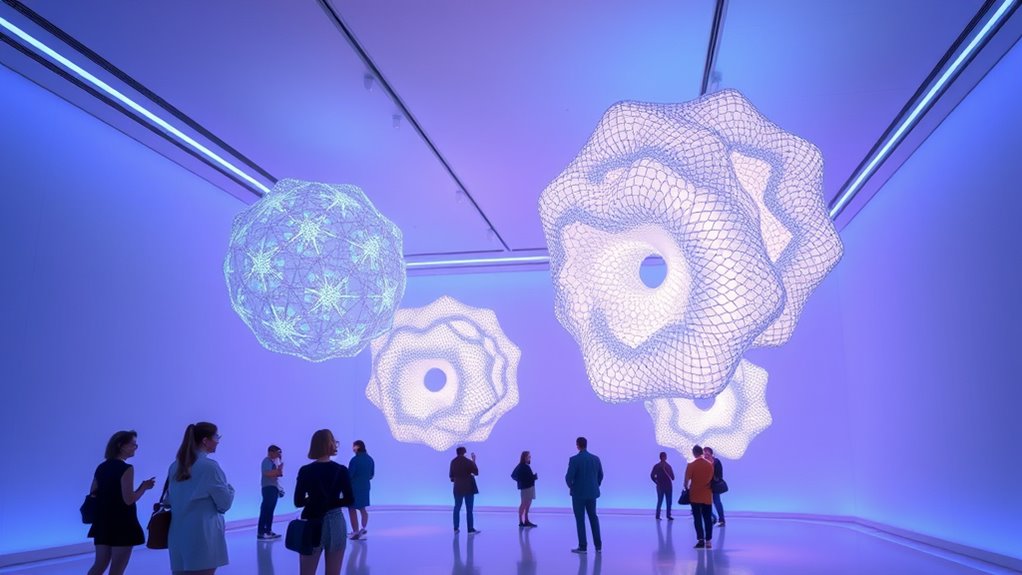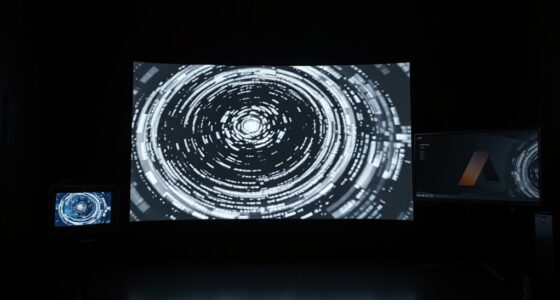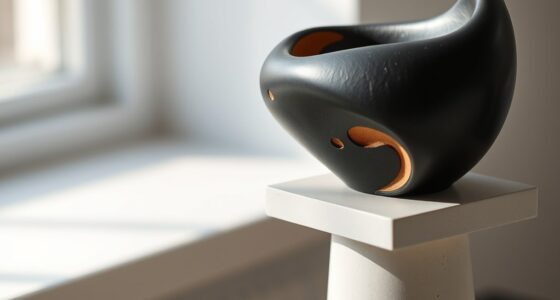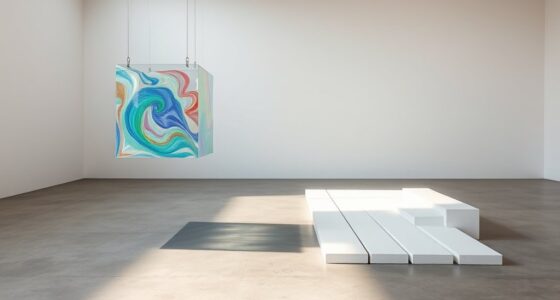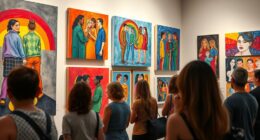AI-powered design is emerging as a groundbreaking art movement that combines algorithms, data analysis, and technology to create innovative visuals. It shifts your focus from traditional intuition to math-driven aesthetics, enabling automation, faster workflows, and new creative possibilities. By collaborating with intelligent systems, you can explore unexpected artistic outcomes and push your creative boundaries. To understand how this integration is shaping art’s future and your own creative approach, stay with us for more insights.
Key Takeaways
- AI-powered design introduces a revolutionary art movement blending algorithms with creativity to create novel aesthetic experiences.
- It emphasizes algorithmic aesthetics, analyzing data to produce complex, harmonious visual patterns beyond manual capabilities.
- The movement fosters creative automation, streamlining workflows and enabling rapid experimentation and innovation.
- It enhances human creativity by serving as a collaborative tool that offers diverse, algorithmically generated artistic options.
- AI-driven design signifies a cultural shift, transforming art creation and perception in the digital age through technology integration.
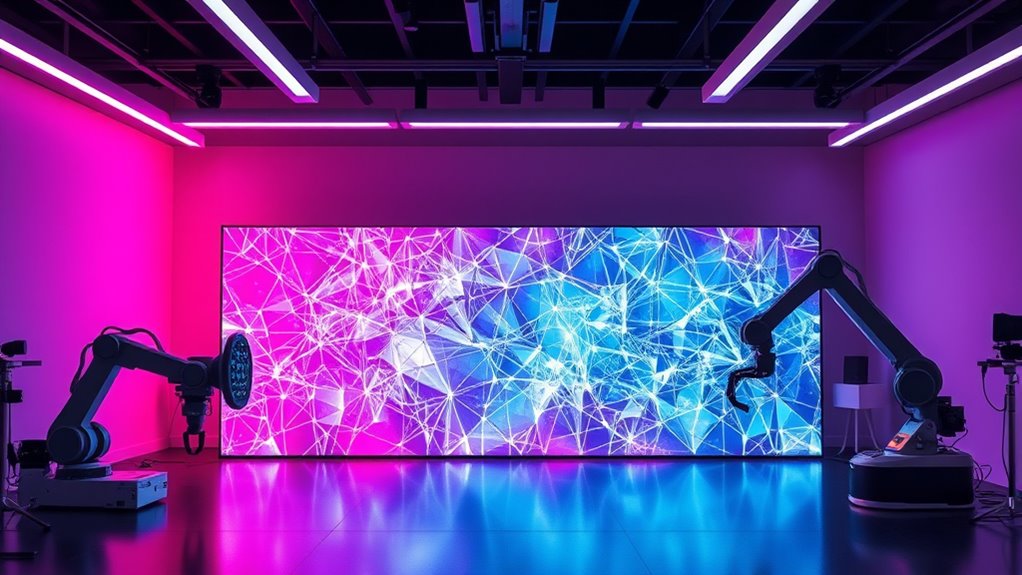
As artificial intelligence becomes increasingly integrated into creative processes, AI-powered design is emerging as a groundbreaking art movement. This shift is revolutionizing how you approach aesthetics, emphasizing algorithmic aesthetics that blend math with artistic expression. Instead of relying solely on human intuition, you now harness complex algorithms to generate visually compelling designs, pushing the boundaries of traditional creativity. This approach allows for a new form of creative automation, where repetitive or intricate tasks are handled by AI, freeing you to focus on conceptual innovation and high-level ideas. The result is a seamless fusion of technology and art, transforming the way you conceive, develop, and present your work.
With algorithmic aesthetics, you tap into the power of data-driven design, where patterns, structures, and color schemes are crafted through mathematical models. These models analyze vast datasets, extracting aesthetic principles that inform your creative choices. As a result, your designs can achieve a harmony and complexity that might be difficult to realize manually. You no longer need to labor over every detail; instead, you set parameters and let the algorithms generate variations, giving you a spectrum of options to refine or inspire your next move. This process democratizes design, making it accessible to those who might lack traditional technical skills but want to experiment with innovative visual styles.
Creative automation is at the core of this movement, enabling you to streamline workflows and produce unique outputs rapidly. Tasks like pattern creation, layout optimization, or even multimedia integration are automated through AI tools, saving you countless hours. This efficiency doesn’t diminish your creative control; rather, it enhances it by offering a palette of algorithmically generated possibilities that challenge your conventional thinking. You can experiment with styles and concepts that were previously too labor-intensive or complex to explore. The automation empowers you to iterate faster, test new ideas, and push your creative limits without being bogged down by technical constraints.
Ultimately, this new art movement driven by AI-powered design isn’t about replacing human creativity but augmenting it. You become a collaborator with intelligent systems, guiding algorithms to realize your vision while discovering unexpected aesthetic outcomes. The fusion of algorithmic aesthetics and creative automation grants you unprecedented freedom to innovate and redefine what art can be. As you embrace this technological evolution, you’re not only shaping future design trends but also contributing to a broader cultural shift where art and technology intertwine seamlessly. This movement invites you to participate actively, exploring new frontiers in visual expression, and transforming how you perceive and create art in the digital age.
Frequently Asked Questions
How Does AI Influence Traditional Artistic Techniques?
AI influences traditional artistic techniques by enhancing your creative process through algorithmic aesthetics and generative creativity. You can experiment with new forms, textures, and patterns that weren’t possible before, blending human intuition with machine precision. This collaboration allows you to push boundaries, challenge conventions, and develop unique artworks. As a result, AI becomes a powerful tool that expands your artistic repertoire, inspiring innovative styles and fresh perspectives in your work.
What Are the Ethical Implications of AI in Art?
You might worry about authenticity concerns and copyright dilemmas when using AI in art. AI blurs the lines between original creation and machine-generated work, raising questions about authorship. You could face ethical dilemmas around ownership and whether AI-produced art is truly yours. It’s crucial to take these issues into account to ensure responsible use, respecting both artists’ rights and the integrity of the creative process.
Can AI Create Truly Original Artwork?
Can AI truly create original artwork? It depends on how you define originality. You might see algorithmic creativity as pushing boundaries, but does it possess genuine inspiration or intent? While AI can generate novel images and concepts, the originality debate continues—are these creations truly unique, or just variations of existing data? Ultimately, AI’s role in art challenges your understanding of authenticity and sparks new conversations about creative ownership.
How Do Artists Collaborate With AI Tools?
You can collaborate with AI tools by using them as a source of ai driven inspiration, sparking your creative ideas. Engage in collaborative creativity by inputting your concepts and letting the AI generate options or variations. You then refine and build upon these outputs, blending human intuition with machine suggestions. This partnership allows you to explore new artistic directions and push boundaries, making your work more innovative and dynamic.
Will AI Replace Human Artists in the Future?
AI won’t fully replace human artists because machine learning enhances your creative autonomy instead of replacing it. You still bring unique ideas, emotions, and personal touches that AI can’t replicate. While AI tools can assist and inspire, your intuition and originality remain essential in the creative process. Embrace AI as a collaborator that expands your possibilities, but your human artistry is irreplaceable in shaping meaningful, authentic art.
Conclusion
You might think AI-powered design lacks human touch, but it actually opens new creative horizons for you. By collaborating with AI, you can push boundaries and explore fresh ideas you might never have considered alone. Embrace this movement as an exciting evolution in art, where technology amplifies your creativity rather than replacing it. So, don’t fear losing your unique voice—trust that AI is a tool that enhances your artistic expression.

